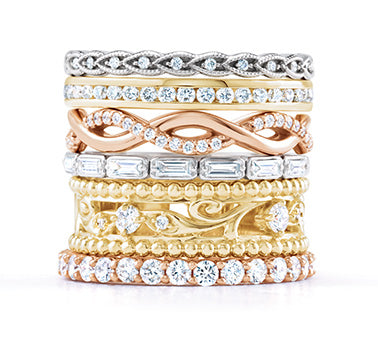Lifetime Warranty
24/7 Hour Customer Service
Free Shipping
30-Day Return
Moijey Fine Jewelry & Diamonds Blog
Why Tourmaline Is Another Rainbow of the Earth
Originally posted on October 20th, 2017
Updated on April 10th, 2020
There is an Egyptian legend that says tourmaline acquired all its colors when it passed through a rainbow. Apparently, according to this anecdote, there is a rainbow in the center of the earth. I wonder if rainbows are in Jules Verne's Journey to the Center of the Earth? Anyway, October babies can enjoy another birthstone in a plethora of colors. Like September babies who can enjoy sapphire in any color besides blue.

This magnificent specimen from the Smithsonian is called "The Steamboat" from sharing similarities with smokestacks. It formed about 100 million years ago in San Diego, California. Remarkable.
Before the advancement of gemology, people mistook tourmaline for other gems. Green tourmaline, for instance, was once thought to be emerald. The name tourmaline comes from toromalli, meaning "mixed gems" in Sinhalese. The name was applied to the colorful waterworn pebbles by Dutch merchants, who found the stones in Ceylon (now Sri Lanka). We can all agree that green tourmaline would make a lovely alternative to emerald in this Green Tourmaline & Diamond Earrings and Pendant suite.



Tourmaline gems share the same triangular crystal structure, but they have slightly different chemical compositions. Depending on the chemicals tourmaline is made from, it will have unique physical properties too.

It's a beautiful combination of just the right amount of manganese to create soft pink. Don't you agree?
Rubellite or red tourmaline (similar to the picture above and the ring below) obtains luscious shades of red from manganese. If the red hue becomes less vibrant under different light sources, it may be called a pink tourmaline. This Rose Gold Tourmaline Ring displays rubellite's vibrant hues.

 Marvelous with the rose gold, don't you agree?
Marvelous with the rose gold, don't you agree?
Green tourmaline or Verdelite can resemble emerald, but the color comes from chrome and vanadium, it's called a chrome tourmaline. Like the green tourmaline, which we showed you earlier.
Particolored tourmaline displays more than one color, due to chemical fluctuations during crystallization. A typical color combination is usually green and pink. They're often cut in slices to reveal a red center surrounded by a green rim, earning the name "watermelon tourmaline."

Schorl is the name of black tourmaline, which originated in a village near Saxony, Germany, called Zschorlau. Black tourmaline mines near the town inspired the name. Iron is responsible for the beautiful black in the chemical composition. Technically, the color is dark shades of either deep brown or bluish-black and schorl forms in a variety of rock types, like this specimen from the Smithsonian with spessartine garnet and quartz.

This marvelous piece is from the Hercules mine in Ramona, California.
Even though schorl makes up 95% of all tourmaline in the world, it technically isn't gem quality. Despite this technicality, schorl was a popular choice in mourning jewelry. If you wish, we can get you an excellent schorl crystal and create a setting for either a pendant, a pair of earrings for smaller schorl crystals, or combine them and create a bonafide suite of black tourmaline with gold and accent diamonds. Call and ask us how.
Schorl, in particular, is said to protect against harmful radiation, toxins, and anxiety. Protection against any type of negativity? Sure. Bring on the schorl!
We'll delve deeper into tourmaline next week. There is just so much to explore. Isn't that great? Enjoy your weekend, everybody.
Why Tourmaline Is Another Rainbow of the Earth
Originally posted on October 20th, 2017
Updated on April 10th, 2020
There is an Egyptian legend that says tourmaline acquired all its colors when it passed through a rainbow. Apparently, according to this anecdote, there is a rainbow in the center of the earth. I wonder if rainbows are in Jules Verne's Journey to the Center of the Earth? Anyway, October babies can enjoy another birthstone in a plethora of colors. Like September babies who can enjoy sapphire in any color besides blue.

This magnificent specimen from the Smithsonian is called "The Steamboat" from sharing similarities with smokestacks. It formed about 100 million years ago in San Diego, California. Remarkable.
Before the advancement of gemology, people mistook tourmaline for other gems. Green tourmaline, for instance, was once thought to be emerald. The name tourmaline comes from toromalli, meaning "mixed gems" in Sinhalese. The name was applied to the colorful waterworn pebbles by Dutch merchants, who found the stones in Ceylon (now Sri Lanka). We can all agree that green tourmaline would make a lovely alternative to emerald in this Green Tourmaline & Diamond Earrings and Pendant suite.



Tourmaline gems share the same triangular crystal structure, but they have slightly different chemical compositions. Depending on the chemicals tourmaline is made from, it will have unique physical properties too.

It's a beautiful combination of just the right amount of manganese to create soft pink. Don't you agree?
Rubellite or red tourmaline (similar to the picture above and the ring below) obtains luscious shades of red from manganese. If the red hue becomes less vibrant under different light sources, it may be called a pink tourmaline. This Rose Gold Tourmaline Ring displays rubellite's vibrant hues.


Green tourmaline or Verdelite can resemble emerald, but the color comes from chrome and vanadium, it's called a chrome tourmaline. Like the green tourmaline, which we showed you earlier.
Particolored tourmaline displays more than one color, due to chemical fluctuations during crystallization. A typical color combination is usually green and pink. They're often cut in slices to reveal a red center surrounded by a green rim, earning the name "watermelon tourmaline."

Schorl is the name of black tourmaline, which originated in a village near Saxony, Germany, called Zschorlau. Black tourmaline mines near the town inspired the name. Iron is responsible for the beautiful black in the chemical composition. Technically, the color is dark shades of either deep brown or bluish-black and schorl forms in a variety of rock types, like this specimen from the Smithsonian with spessartine garnet and quartz.

This marvelous piece is from the Hercules mine in Ramona, California.
Even though schorl makes up 95% of all tourmaline in the world, it technically isn't gem quality. Despite this technicality, schorl was a popular choice in mourning jewelry. If you wish, we can get you an excellent schorl crystal and create a setting for either a pendant, a pair of earrings for smaller schorl crystals, or combine them and create a bonafide suite of black tourmaline with gold and accent diamonds. Call and ask us how.
Schorl, in particular, is said to protect against harmful radiation, toxins, and anxiety. Protection against any type of negativity? Sure. Bring on the schorl!
We'll delve deeper into tourmaline next week. There is just so much to explore. Isn't that great? Enjoy your weekend, everybody.






